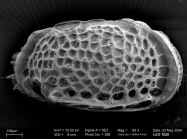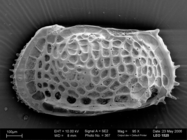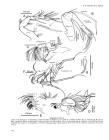Ostracoda taxon details
Poseidonamicus yasuharai Brandão & Päplow, 2011
579337 (urn:lsid:marinespecies.org:taxname:579337)
accepted
Species
marine, brackish, fresh, terrestrial
recent only
Brandão, S. N.; Päplow, O. (2011). New species and occurrences of <i>Bradleya</i> Benson, 1972, <i>Harleya</i> Jellinek & Swanson, 2003 and <i>Poseidonamicus</i> Benson, 1972 (Ostracoda: Cytheroidea) from the Atlantic Sector of the Southern Ocean. <em>Journal of Micropalaeontology.</em> 30(2): 141-166., available online at https://doi.org/10.1144/0262-821x10-017 [details] Available for editors  [request]
[request]
Description "Valves sub-rectangular in lateral view, males more elongate than females. Dorsal margin slightly sinuous; dorsal ridge...
Description z(continued) "Segment I of sixth limb dorsally with 2 setae, one of which is annulated; ventrally with seta-like exopodite;...
Etymology "In honour of Dr Moriaki Yasuhara, Smith- sonian Institution, for his work on deep-sea ostracods and climate change."
Description "Valves sub-rectangular in lateral view, males more elongate than females. Dorsal margin slightly sinuous; dorsal ridge very weak; anterior margin with 8 to 18 spines; posterior margin with up to 10 spines, a few of them robust and long. Ventrolateral ridge well developed, with 1 robust and long spine arising on its posterior end. Marginal rims (i.e. anterior-most and posterior-most areas of lateral surface) smooth and wide. Anterior muri more robust than posterior ones. Deep and rounded fossae just dorsal to ventrolateral ridge. Fossae in anterior field smaller, deeper and more rounded than those in posterior field. Posterior fossae polygonal and arranged regu- larly in sub-vertical rows. Anterior field separated from the posterior field by slight mural loop. Carapace arrow-shaped and rounded in dorsal and ventral views. Hinge holamphidont. Four vertically aligned and undivided adductor muscle scars, plus three frontal scars. Valves lack both ocular sinuses and eye tubercles.
Antennula with only 5 articulated segments; segments I and II fused; segments V and VI also fused. Segment I and II without setae but with some unarticulated barbulae. Segment III termi- nally with 1 long, ventrolateral seta, unarticulated barbulae also present on dorsal and ventral margins. Segment IV with one dorsal seta. Segment V with 4 distal setae and one lateral, possibly sensory seta (because of its rounded tip). Segment VI (fused to segment V) with 5 distal setae: 2 normal setae, 1 reduced seta and 2 claws. Segment VII with 2 distal claws and 1 modified structure (i.e. ‘1fsc’ in chaetotaxy formula), which is possibly an aesthetasc fused to a claw. Supposedly sensory part of this modified seta is rounded and flexible.
Segments I and II of antenna fused and without seta. Segment III with 1 dorsal seta and 1 very long, ventral seta. Exopodite 3-segmented and modified as a spinneret seta. Seg- ments IV and V fused. Segment IV dorso-distally with 2 setae; ventro-distally with 1 seta, 1 barbed claw, and 1 supposedly sensory, ‘candle-shaped’ seta with a flattened tip. Segment V without setae both dorsally and ventrally, but distally with 1 claw and 1 reduced seta. Segment VI with 2 ventral claws and 1 distal claw.
The mandibula consists of a strongly sclerotized masticatory process (= coxa) with 1 short, distal seta, around 5 strong teeth (endites) and a segmented palp. The mandibular palp consists of a basis (basipodite of some authors), a 1-segmented exopodite and a 2-segmented endopodite. Segment II (= basis) ventrally with 3 setae: 1 normal seta, 1 ‘carrot-like’ seta, 1 plumose seta; ventro-distally with 1 long, plumose seta and 2 simple setae. Exopodite with 5 distal seta, one of these long and plumose. Segment III (= endopoite segment 1) with 5 distal setae, 1 dorsal seta, 3 simple lateral setae, and 1 lateral plumose seta. Segment IV with 4 distal setae, 1 of them annulated.
Maxillula basis with three endites (or masticatory lobes, or masticatory processes), a 2-segmented endopodite (= palp), a well-developed exopodite (or vibratory plate). Exopodite flat and large, with 15 distal ‘Strahlen’ and one proximal, plumose, dorsal, aberrant ‘Strahl’. Endite I with 6 distal setae. Endite II with 5 distal setae and 1 thick, ventrolateral seta. Endite III with 5 to 6 distal setae. Segment I of palp with 1 thick, long lateral seta and 4 dorso-distal setae. Segment II with 2 long setae and 1 short seta. Palp as thick as endites.
Segment I of fifth limb dorsally with 2 annulated setae; distally with 2 annulated setae; ventrally with a ‘carrot-like’ exopodite (dashed and marked with a ‘*’ in Plate 9, fig. F and detailed in Plate 9, fig. G). Segment II dorsally with 1 short, thick, distal seta. Segment III without seta. Segment IV with 1 long, distal claw. [details]
Antennula with only 5 articulated segments; segments I and II fused; segments V and VI also fused. Segment I and II without setae but with some unarticulated barbulae. Segment III termi- nally with 1 long, ventrolateral seta, unarticulated barbulae also present on dorsal and ventral margins. Segment IV with one dorsal seta. Segment V with 4 distal setae and one lateral, possibly sensory seta (because of its rounded tip). Segment VI (fused to segment V) with 5 distal setae: 2 normal setae, 1 reduced seta and 2 claws. Segment VII with 2 distal claws and 1 modified structure (i.e. ‘1fsc’ in chaetotaxy formula), which is possibly an aesthetasc fused to a claw. Supposedly sensory part of this modified seta is rounded and flexible.
Segments I and II of antenna fused and without seta. Segment III with 1 dorsal seta and 1 very long, ventral seta. Exopodite 3-segmented and modified as a spinneret seta. Seg- ments IV and V fused. Segment IV dorso-distally with 2 setae; ventro-distally with 1 seta, 1 barbed claw, and 1 supposedly sensory, ‘candle-shaped’ seta with a flattened tip. Segment V without setae both dorsally and ventrally, but distally with 1 claw and 1 reduced seta. Segment VI with 2 ventral claws and 1 distal claw.
The mandibula consists of a strongly sclerotized masticatory process (= coxa) with 1 short, distal seta, around 5 strong teeth (endites) and a segmented palp. The mandibular palp consists of a basis (basipodite of some authors), a 1-segmented exopodite and a 2-segmented endopodite. Segment II (= basis) ventrally with 3 setae: 1 normal seta, 1 ‘carrot-like’ seta, 1 plumose seta; ventro-distally with 1 long, plumose seta and 2 simple setae. Exopodite with 5 distal seta, one of these long and plumose. Segment III (= endopoite segment 1) with 5 distal setae, 1 dorsal seta, 3 simple lateral setae, and 1 lateral plumose seta. Segment IV with 4 distal setae, 1 of them annulated.
Maxillula basis with three endites (or masticatory lobes, or masticatory processes), a 2-segmented endopodite (= palp), a well-developed exopodite (or vibratory plate). Exopodite flat and large, with 15 distal ‘Strahlen’ and one proximal, plumose, dorsal, aberrant ‘Strahl’. Endite I with 6 distal setae. Endite II with 5 distal setae and 1 thick, ventrolateral seta. Endite III with 5 to 6 distal setae. Segment I of palp with 1 thick, long lateral seta and 4 dorso-distal setae. Segment II with 2 long setae and 1 short seta. Palp as thick as endites.
Segment I of fifth limb dorsally with 2 annulated setae; distally with 2 annulated setae; ventrally with a ‘carrot-like’ exopodite (dashed and marked with a ‘*’ in Plate 9, fig. F and detailed in Plate 9, fig. G). Segment II dorsally with 1 short, thick, distal seta. Segment III without seta. Segment IV with 1 long, distal claw. [details]
Description z(continued) "Segment I of sixth limb dorsally with 2 setae, one of which is annulated; ventrally with seta-like exopodite;...
Description z(continued) "Segment I of sixth limb dorsally with 2 setae, one of which is annulated; ventrally with seta-like exopodite; and distally with 1 short, thick, annulated seta. Segment II dorsally with 1 short, thick, distal seta. Segment III without seta. Segment VI distally with 1 long claw.
Segment I of seventh limb dorsally with 1 long, annulated seta, distally with 1 annulated seta; ventrally with seta-like, annulated exopodite. Segment II dorsally with 1 short, thick, distal seta. Segment III without setae. Segment IV distally with 1 long claw.
Basal capsule of male copulatory limb sub-oval with a sharpened, distal end. Labyrinth heavily sclerotized. Copulatory process short and straight. Three lobes attached to the basal capsule: (1) smallest (dorsal) is elongated; (2) medium-sized one is medially positioned and sub-triangular; (3) largest (laterally positioned) is sub-circular.
Furca reduced to 2 plumose setae, 1 of these long, the other short." [details]
Segment I of seventh limb dorsally with 1 long, annulated seta, distally with 1 annulated seta; ventrally with seta-like, annulated exopodite. Segment II dorsally with 1 short, thick, distal seta. Segment III without setae. Segment IV distally with 1 long claw.
Basal capsule of male copulatory limb sub-oval with a sharpened, distal end. Labyrinth heavily sclerotized. Copulatory process short and straight. Three lobes attached to the basal capsule: (1) smallest (dorsal) is elongated; (2) medium-sized one is medially positioned and sub-triangular; (3) largest (laterally positioned) is sub-circular.
Furca reduced to 2 plumose setae, 1 of these long, the other short." [details]
Etymology "In honour of Dr Moriaki Yasuhara, Smith- sonian Institution, for his work on deep-sea ostracods and climate change."
Etymology "In honour of Dr Moriaki Yasuhara, Smith- sonian Institution, for his work on deep-sea ostracods and climate change." [details]
Brandão, S.N.; Antonietto, L.S; Nery, D.G.; Pereira, J.S.; Praxedes, R.A.; Santos, S.G.; Karanovic, I. (2024). World Ostracoda Database. Poseidonamicus yasuharai Brandão & Päplow, 2011. Accessed at: https://www.marinespecies.org/ostracoda/aphia.php?p=taxdetails&id=579337 on 2024-11-20
Date
action
by
original description
Brandão, S. N.; Päplow, O. (2011). New species and occurrences of <i>Bradleya</i> Benson, 1972, <i>Harleya</i> Jellinek & Swanson, 2003 and <i>Poseidonamicus</i> Benson, 1972 (Ostracoda: Cytheroidea) from the Atlantic Sector of the Southern Ocean. <em>Journal of Micropalaeontology.</em> 30(2): 141-166., available online at https://doi.org/10.1144/0262-821x10-017 [details] Available for editors  [request]
[request]
 Present
Present  Inaccurate
Inaccurate  Introduced: alien
Introduced: alien  Containing type locality
Containing type locality
From editor or global species database
Description "Valves sub-rectangular in lateral view, males more elongate than females. Dorsal margin slightly sinuous; dorsal ridge very weak; anterior margin with 8 to 18 spines; posterior margin with up to 10 spines, a few of them robust and long. Ventrolateral ridge well developed, with 1 robust and long spine arising on its posterior end. Marginal rims (i.e. anterior-most and posterior-most areas of lateral surface) smooth and wide. Anterior muri more robust than posterior ones. Deep and rounded fossae just dorsal to ventrolateral ridge. Fossae in anterior field smaller, deeper and more rounded than those in posterior field. Posterior fossae polygonal and arranged regu- larly in sub-vertical rows. Anterior field separated from the posterior field by slight mural loop. Carapace arrow-shaped and rounded in dorsal and ventral views. Hinge holamphidont. Four vertically aligned and undivided adductor muscle scars, plus three frontal scars. Valves lack both ocular sinuses and eye tubercles.Antennula with only 5 articulated segments; segments I and II fused; segments V and VI also fused. Segment I and II without setae but with some unarticulated barbulae. Segment III termi- nally with 1 long, ventrolateral seta, unarticulated barbulae also present on dorsal and ventral margins. Segment IV with one dorsal seta. Segment V with 4 distal setae and one lateral, possibly sensory seta (because of its rounded tip). Segment VI (fused to segment V) with 5 distal setae: 2 normal setae, 1 reduced seta and 2 claws. Segment VII with 2 distal claws and 1 modified structure (i.e. ‘1fsc’ in chaetotaxy formula), which is possibly an aesthetasc fused to a claw. Supposedly sensory part of this modified seta is rounded and flexible.
Segments I and II of antenna fused and without seta. Segment III with 1 dorsal seta and 1 very long, ventral seta. Exopodite 3-segmented and modified as a spinneret seta. Seg- ments IV and V fused. Segment IV dorso-distally with 2 setae; ventro-distally with 1 seta, 1 barbed claw, and 1 supposedly sensory, ‘candle-shaped’ seta with a flattened tip. Segment V without setae both dorsally and ventrally, but distally with 1 claw and 1 reduced seta. Segment VI with 2 ventral claws and 1 distal claw.
The mandibula consists of a strongly sclerotized masticatory process (= coxa) with 1 short, distal seta, around 5 strong teeth (endites) and a segmented palp. The mandibular palp consists of a basis (basipodite of some authors), a 1-segmented exopodite and a 2-segmented endopodite. Segment II (= basis) ventrally with 3 setae: 1 normal seta, 1 ‘carrot-like’ seta, 1 plumose seta; ventro-distally with 1 long, plumose seta and 2 simple setae. Exopodite with 5 distal seta, one of these long and plumose. Segment III (= endopoite segment 1) with 5 distal setae, 1 dorsal seta, 3 simple lateral setae, and 1 lateral plumose seta. Segment IV with 4 distal setae, 1 of them annulated.
Maxillula basis with three endites (or masticatory lobes, or masticatory processes), a 2-segmented endopodite (= palp), a well-developed exopodite (or vibratory plate). Exopodite flat and large, with 15 distal ‘Strahlen’ and one proximal, plumose, dorsal, aberrant ‘Strahl’. Endite I with 6 distal setae. Endite II with 5 distal setae and 1 thick, ventrolateral seta. Endite III with 5 to 6 distal setae. Segment I of palp with 1 thick, long lateral seta and 4 dorso-distal setae. Segment II with 2 long setae and 1 short seta. Palp as thick as endites.
Segment I of fifth limb dorsally with 2 annulated setae; distally with 2 annulated setae; ventrally with a ‘carrot-like’ exopodite (dashed and marked with a ‘*’ in Plate 9, fig. F and detailed in Plate 9, fig. G). Segment II dorsally with 1 short, thick, distal seta. Segment III without seta. Segment IV with 1 long, distal claw. [details]
Description z(continued) "Segment I of sixth limb dorsally with 2 setae, one of which is annulated; ventrally with seta-like exopodite; and distally with 1 short, thick, annulated seta. Segment II dorsally with 1 short, thick, distal seta. Segment III without seta. Segment VI distally with 1 long claw.
Segment I of seventh limb dorsally with 1 long, annulated seta, distally with 1 annulated seta; ventrally with seta-like, annulated exopodite. Segment II dorsally with 1 short, thick, distal seta. Segment III without setae. Segment IV distally with 1 long claw.
Basal capsule of male copulatory limb sub-oval with a sharpened, distal end. Labyrinth heavily sclerotized. Copulatory process short and straight. Three lobes attached to the basal capsule: (1) smallest (dorsal) is elongated; (2) medium-sized one is medially positioned and sub-triangular; (3) largest (laterally positioned) is sub-circular.
Furca reduced to 2 plumose setae, 1 of these long, the other short." [details]
Diagnosis "A large, moderately calcified, Poseidonamicus with sub-rectangular outline, sub-parallel and sub-rectilinear dorsal and ventral margins and ventrolateral ridge. Dorsal ridge very weak, projecting dorsally and joining the dorsal margin of the valve. Fossae shallow, muri low. Only primary ornamentation present on lateral surface. Posterior margin with up to 10 spines, anterior margin with 8 to 18 spines. Three frontal muscle scars." [details]
Dimensions "Holotype: adult male – SNB 0211, LV L 1.06 mm, H 0.60 mm; RV L 1.07 mm, H 0.58 mm. Paratypes: adult males –SNB0626,LVL1.14mm,H0.61mm;RVL1.15mm,H0.64 mm; SNB 0887, LV L 1.12mm, H 0.60 mm; RV L 1.10mm, H 0.59 mm; adult females – SNB 0006, LV L 1.06 mm, H 0.59 mm; RV L 1.05mm, H 0.60 mm; SNB 0210, LV L 1.00mm, H 0.57 mm; RV L 1.00mm, H 0.56 mm. (A-1) – SNB 0315, LV L 0.88 mm, H 0.49 mm; RV L 0.88 mm, H 0.47 mm. Adult subfossils: W 0.50–0.62 mm; (A-1) subfossil W 0.43 mm." [details]
Etymology "In honour of Dr Moriaki Yasuhara, Smith- sonian Institution, for his work on deep-sea ostracods and climate change." [details]



